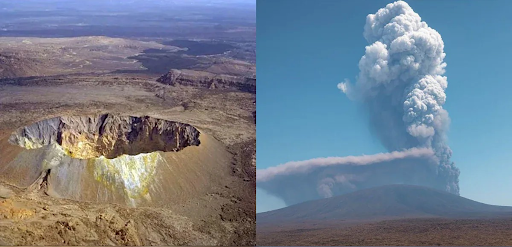



UN ESCAP’s 2025 report warns that Asian megacities may experience an additional 2–7°C due to urban heat island effects, with India, Pakistan and Bangladesh facing 300+ days above 35°C. Extreme heat is now the region’s fastest-growing climate hazard, threatening health, livelihoods and economic stability.

Copyright infringement not intended
Picture Courtesy: Down to Earth
According to UN Economic and Social Commission for Asia and the Pacific (ESCAP) report Asian megacities face deadly heatwave risk.
Must Read: HEATWAVES | Humid heat waves in India | HOW EXTREME HEAT IS AFFECTING INDIA? | HEAT WAVES AND ENSO | |
A heat wave is a prolonged period of abnormally high temperature, often combined with high humidity, that exceeds the normal climatic patterns of a region and poses significant health, environmental, social, and economic risks.
Based on Actual Maximum Temperature
A heatwave is declared when:
Departure from Normal
Heatwave:
Severe Heatwave:
Absolute Temperature Threshold (Fixed Criterion)
Heatwave:
Severe Heatwave:
|
Colour Code |
Meaning |
Criteria |
Advisory |
|
Green |
No Warning |
No heatwave conditions expected; temperatures within normal range |
No action needed; normal monitoring |
|
Yellow (Be Aware) |
Heatwave Likely |
Heatwave conditions expected at isolated pockets; initial rise in temperature meeting heatwave thresholds |
Public should stay alert, avoid prolonged sun exposure, maintain hydration |
|
Orange (Be Prepared) |
Severe Heatwave Likely / Persistent Heatwave |
Severe heatwave in many pockets OR heatwave expected to persist for several days |
Authorities must prepare heat action response: cooling centres, water distribution, advisories for vulnerable groups |
|
Red (Take Action) |
Severe to Very Severe Heatwave |
Severe or very severe heatwave already prevailing or highly likely in widespread areas |
Immediate action required: modify work hours, medical preparedness, public warnings, limit outdoor activities |
According to UN Economic and Social Commission for Asia and the Pacific (ESCAP) report
Urban Heat Island (UHI) Intensification
Chronic Heat Exposure Across South & Southwest Asia (Broad One-Line Statements)
Heat as the fastest-growing climate hazard
Socio-economic inequality and heat
Heat–air Pollution feedback loop
Public Health Crisis: Heatwaves overwhelm the body’s thermoregulation, leading to heat stress, dehydration, kidney injury, cardiovascular strain and heatstroke. India 2024 heatwave killed around 700, becoming the second deadliest event of the year.
Labour Productivity Loss: Heat stress reduces physical work capacity, impacting labour-intensive sectors such as agriculture, construction, mining, logistics, and gig work. According to ILO report India may lose 34 million full-time jobs equivalent by 2030 due to heat stress.
Agricultural Losses: Heatwaves deteriorate soil moisture, disrupt crop growth cycles, and increase evapotranspiration. According to IPCC (2022) report for every 1°C rise, wheat yields can drop by 6% in South Asia.
Urban Overheating: A Bandung (Indonesia) microclimate study documented a 7°C temperature gap between informal settlements and green-rich neighbourhoods—one of the largest urban thermal disparities recorded in Southeast Asia.
Water stress and power demand peaks: India’s national peak power demand hit 234 GW in June 2023, the highest at the time, directly attributed to severe heatwave conditions across north India. Bengaluru’s 2024 summer water crisis coincided with prolonged heat spells, affecting ~2 million people due to drying borewells and reduced Cauvery inflows.
|
Constitutional Challenges Article 21 – Right to Life Supreme Court has interpreted right to life to include:
Heatwaves threaten:
Article 47 – Duty of State to Improve Public Health Heat-health action plans become constitutional obligations. |
National Action Plan on Climate Change (NAPCC) – Mission on Sustainable Habitat targets cooling, transport, urban planning.
India Cooling Action Plan (ICAP) – First global plan to reduce cooling demand by 20–25% by 2037.
National Disaster Management Authority (NDMA) Heat Action Plan Guidelines (2016):
Atal Mission for Rejuvenation and Urban Transformation (AMRUT): AMRUT promotes climate-resilient urban development by expanding green cover, restoring and creating water bodies, enhancing urban wetlands, and improving stormwater drainage—all of which help lower surface temperatures, reduce urban heat island effects, and strengthen long-term heat resilience.
Smart Cities Mission: The Smart Cities Mission integrates heat-adaptive urban design through measures such as cool roofs, reflective and permeable pavements, smart shading systems, green corridors, and climate-responsive building codes, alongside digital monitoring systems that support heat early warnings and urban microclimate management.
Green India Mission (GIM): The Green India Mission advances urban and peri-urban afforestation, ecological restoration, and landscape-scale greening to improve carbon sequestration, enhance ecosystem services, regulate microclimates, and create heat-buffer zones that mitigate rising temperatures in densely populated regions.
Scale Up Heat-Health Early Warning Systems (HHEWS) Beyond Current Coverage
Only 54% of global meteorological agencies issue heat alerts according to UN ESCAP 2025 report.
India must expand district-level, hyperlocal heat alerts.
Mandate Cool Roofs and Heat-Resilient Building Codes
Hyderabad’s cool-roof initiative (2023–24) covered 300,000 sq. m and reduced indoor temperatures by 2–4°C in low-income households.
Urban Greening Using Microclimate Science, Not Generic Plantation Drives
Cities must adopt heat-mitigating species (Neem, Peepal, Banyan, Rain tree) and continuous green corridors, based on studies showing surface-temperature reduction of up to 5°C around urban forests.
Heat-Safe Work Regulations for Informal & Gig Workers
India lacks binding heat-safety standards. It must adopt
Asia’s megacities are entering an era of chronic heat, driven by global warming, UHI, and rapid urbanisation. The UN ESCAP report makes clear that extreme heat is now the fastest-growing climate hazard with deep socio-economic, health, and constitutional implications. Targeted heat-health systems, resilient urban planning, worker protection and regional cooperation are essential to safeguard millions in South and Southwest Asia.
|
Practice Question “Extreme heat is the fastest-growing climate hazard in Asia.” Discuss (250 words) |
Heatwaves are rising due to higher baseline temperatures from climate change, weakening monsoon circulation during El Niño years, and rapid land-use changes. UN ESCAP (2025) shows India, Pakistan, and Bangladesh may face 300+ days annually with heat index above 35°C, making South Asia the world’s most heat-stressed region.
High humidity in the Bay of Bengal and Arabian Sea regions raises the heat index, meaning even 36–38°C can feel like 45–50°C. For example, the Bangladesh 2024 heatwave reached heat index values above 50°C, causing school closures nationwide.
Mortality is driven by humidity + temperature. At heat index >41°C, the body cannot cool effectively even at 38–40°C. India’s 2024 heatwave deaths (~700) occurred mostly at temperatures between 40–43°C, not above 45°C.





© 2025 iasgyan. All right reserved